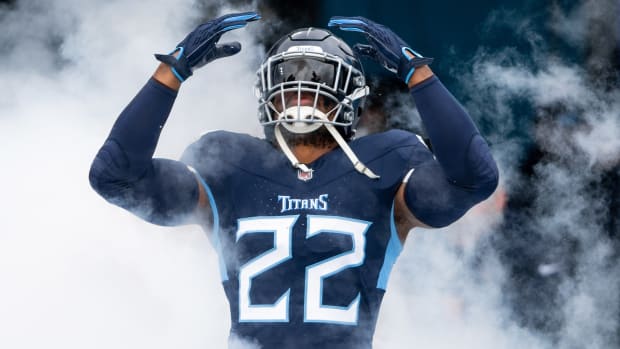How the Titans Consistently Stop the Run
NASHVILLE – It’s a challenge to find the right word to describe what the Tennessee Titans’ defense has done to opponents’ running games over the past eight games.
Stuffed? Doesn’t do it justice.
Smothered? Not violent enough.
Demolished? Maybe we’re getting somewhere.
Annihilated? That seems about right.
The Titans will head into Sunday’s game against the Cincinnati Bengals seeking to hold an opponent under 100 rushing yards for a ninth straight game, which would be a franchise record.
Officially, the Titans are only the NFL’s second-best run defense, allowing an average of 82.2 yards on the ground. That puts them a hair behind the San Francisco 49ers (81.1).
But what the Titans have done to opponents’ running attacks over the past eight games – seven wins – is borderline obscene, far-and-away the best in the league.
Some highlights:
• The Titans have surrendered a total of just 483 rushing yards, an average of 60.4 per contest. Every other team in the NFL has allowed a minimum of 676 rushing yards during that stretch, a minimum of 84.5 per contest. That’s a massive discrepancy.
• The Titans have allowed all of one rushing touchdown while every other team has surrendered a minimum of four.
• Despite going up against some of the NFL’s better backs during that stretch – Indianapolis’ Jonathan Taylor (twice), Las Vegas’ Josh Jacobs, Houston’s Dameon Pierce and Green Bay’s Aaron Jones – the Titans haven surrendered only three runs of 15 yards or more, zero of more than 20 yards.
Does breaking the will of an opponents’ running game like that provide a psychological boost?
“Yeah, it does, because if you’ve been on the other end of it, and they’re running (the ball) and you can’t stop it, it’s not a good feeling,” Titans defensive line coach Terrell Williams said. “It’s demoralizing, really. So when you can stop the run and make teams one-dimensional, then it just makes it easier for you to do your job.”
Tennessee doesn't complicate matters when it comes to stopping the run.
It comes down to three keys – setting the edge, building a wall and swarming to the football.
Here’s what is so important about each element.
Setting the Edge
It’s the job of the defensive ends and outside linebackers to contain the scope of the run, to limit the ability of blockers to push wide – thereby keeping the running back contained and funneling him toward the middle of the field.
“When you don’t have that edge set, these (running backs) are athletic to where they can bounce, jump-cut three, four yards at a time and bounce it out, just outrun you sideways and cut to the sideline,” outside linebacker Rashad Weaver said. “We have to do a good job setting the edge so that we can all eat. Just close every hole for the running back.”
Building the Wall
Once the edge is set successfully and the running back’s space is limited, it’s up to the interior defensive linemen – like Jeffery Simmons, Teair Tart, Denico Autry (who also plays on the outside) and Kevin Strong among others – to create a massive unified front.
That means staying as square as possible to the line of scrimmage, the blockers and the back – as opposed to leaning and twisting, which create seams running backs can squeeze through.
“I always describe it as, if we’re standing shoulder to shoulder, it’s hard for somebody to walk through us,” Williams said. “But when you start turning (your body), it’s a little easier. It’s just as simple as that, and that’s about how simply we put it. They’re doing what we ask them to do.”
Swarming to the Ball
When the edges are set and the wall built successfully, the lanes for an opposing running back are limited. The holes that remain open? It’s up to every able-bodied defender to help close them, but inside linebackers need to be especially effective here.
David Long, who leads the Titans with 80 tackles (including seven for loss) has turned into a demon filling the role this year. But he’s had plenty of help as well, from players like safety Kevin Byard and fellow inside linebacker Dylan Cole among others.
“If we just give (a running back) the one or two holes,” Weaver said, “we know David and those linebackers are filling there.”
Added Williiams: “We build a wall and let the linebackers run. They run and hit. That’s really what it is.”
It is also effective, so much so that if the Titans hold the Bengals under 100 rushing yards on Sunday it will be time to update the franchise record book.
“Other teams may play the run a little differently, where some D-linemen get up the field and the (linebackers) kind of play off those guys,” Byard said. “But for us, it’s set an edge and build a wall of guys, to where the running back doesn’t have anywhere to go, and then everybody just swarm and go tackle him. That’s the way we do it, and that’s why we’ve been pretty good at it.”






